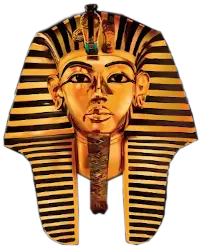
(v) SUMMARY OF CONCLUSIONS.
The doctrines of Plato are eclectic and point to Egyptian origin.
1. The doctrine of the real and unreal to represent doctrine found in the comparison between natural phenomena and the Ideas, is only an instance of the application of the doctrine of opposites. Here the things of this world have their corresponding types in the heavenly realm; here the Ideas correspond to Being, while the natural phenomena correspond to not-Being. But the doctrine of opposites may be traced back not only to Socrates, Democritus, Parmenides and the Pythagoreans, but further back to its original source, i.e., the Egyptian Mystery System, where the principle of opposites was represented not only by pairs of male and female Gods, such as Osiris and Isis, but also by pairs of pillars in the front of all the Egyptian temples.
(Memphite Theology in Kingship and the Gods, by Frankfort, C. 3, p. 25-26 and 35).
(Herodotus I, 6-26) (Ancient Egypt by John Kendrick, Bk. I, p. 339).
(Egyptian Religion by Frankfort, p. 64, 73, 88). (Zeller's Hist. of Phil. p. 61).
(The Phaedo C. 15, 16, 49).
II. The doctrine of the Nous or World Soul is a principle of Egyptian magic:
Plato is credited with expressing this doctrine in the form of a simile, in which he compares the world to a living animal, which is composed of Souls. One being made perfect and responsible for the life, motion and knowledge of the animal or universe.
This doctrine may be traced not only to (a) Democritus who based his teaching about the fire atoms of the soul, and cognition upon the magical principle of the Egyptians: "that the qualities of an animal are distributed throughout its parts."
Topics
Greek Philospohy is Stolen Egyptian Philosophy
The Memphite Theology is the Basis of all Important Doctrines of Greek Philosophy
Greek Philosophy was Alien to the Greeks
Greek Philosophy was the offspring of the Egyptian Mystery System
The Egyptians Educated the Greeks
The Curriculum of the Egyptian Mystery System
The Pre-Socratic Philosophers and the teaching Ascribed to them
The Athenian Philosophers
1. Socrates
2. Plato
3. Aristotle